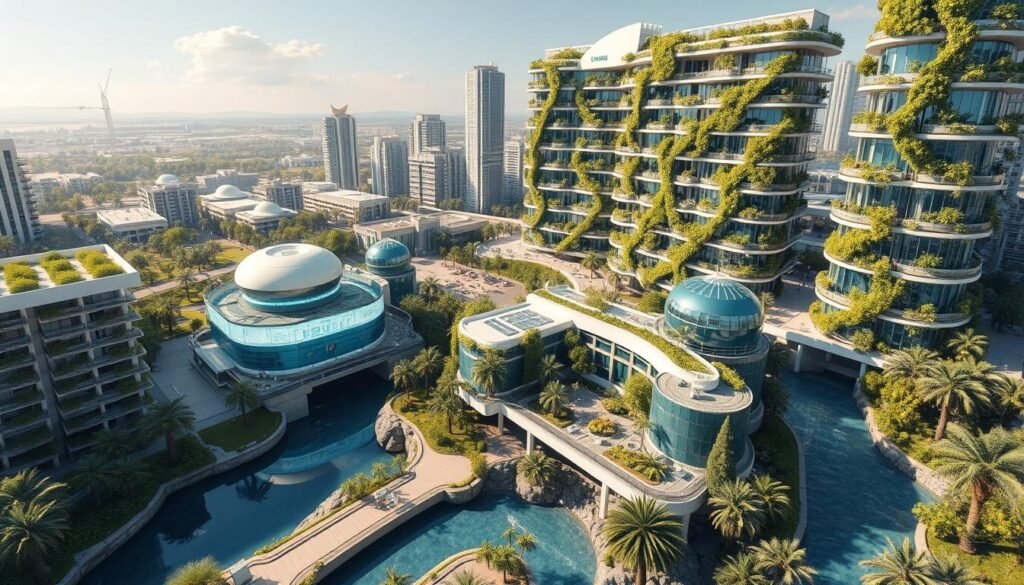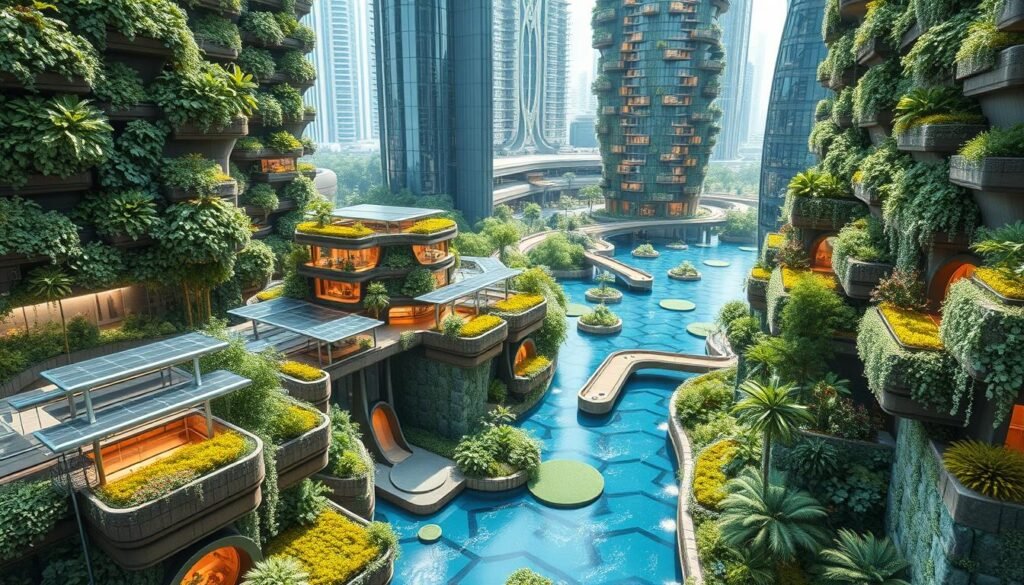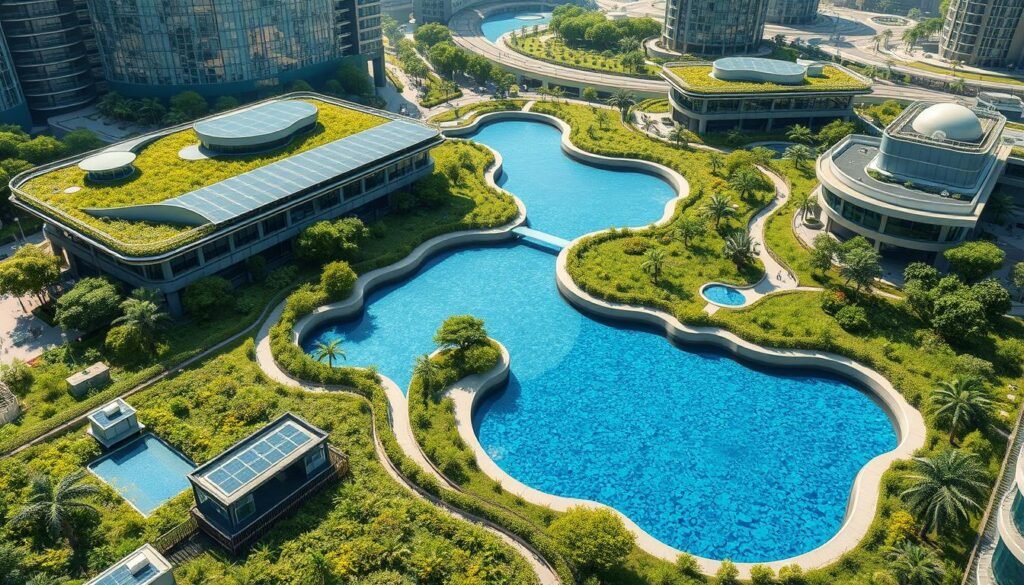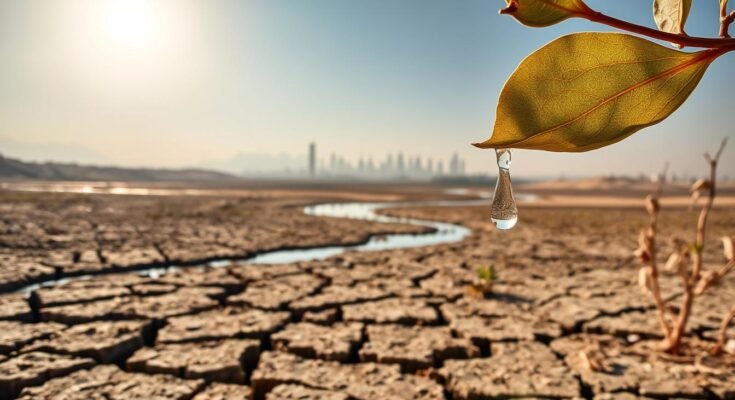The world is facing a big challenge in saving water. Over 40% of people globally don’t have enough water, and more than 700 million lack clean drinking water. Climate change, growing populations, and higher living standards are making it harder to find freshwater.
These issues cause both physical and economic water shortages. 785 million people don’t have basic drinking water, and 2 billion lack proper sanitation.
Climate change is changing how water falls and melts, making it harder to get and share Water Conservation. More people and cities are also using up water faster than we can treat it.
To solve these problems, we need many different solutions. We need better water management, education, and new technologies like desalination and recycling. By using these methods, we can make sure everyone has clean water for the future.
Key Takeaways
- More than 40% of the global population experiences water scarcity, with over 700 million people lacking access to clean drinking water.
- Climate change, population growth, and rising standards of living are the primary drivers of the global water crisis, leading to physical and economic water scarcity.
- Addressing the water crisis requires a comprehensive approach, including governance, education, infrastructure development, and innovative solutions like desalination and water recycling.
- Centralized water management and effective conservation practices are crucial to ensuring the sustainable use of this vital resource.
- Technological advancements and the adoption of smart water infrastructure can play a significant role in addressing the challenges of the global water crisis.
Global Water Scarcity Crisis: Current State and Impacts
The world is facing a severe water scarcity crisis. Over 700 million people lack access to clean water. This problem is made worse by physical and economic water scarcity.
Physical Water Scarcity vs. Economic Water Scarcity
Physical water scarcity happens when there’s not enough water to meet demand. This is often due to overuse or unsustainable practices. Economic water scarcity, on the other hand, is caused by a lack of investment in water systems. This limits access to water, even when it’s available.
Climate Change Effects on Water Resources
Climate change is making the water scarcity crisis worse. Changes in rain patterns, more floods and droughts, and earlier snowmelt are all causing water stress. The IPCC says limiting warming to 1.5°C could reduce water scarcity by half.
Population Growth and Urbanization Pressure
Population growth and urbanization are also straining water resources. Agriculture uses 70% of freshwater, and the demand for food is increasing. The UN says over half the world’s population faces water scarcity for at least a month each year.
The effects of water scarcity are severe. They include desertification, forced migration, hunger, diseases, and conflicts. To tackle this, we need sustainable water management, investments in infrastructure, and new ways to make water more available and accessible.
“Water scarcity is one of the greatest challenges of our time, with over 700 million people globally lacking access to clean water. This crisis is exacerbated by physical water depletion, economic constraints, climate change, and growing population and urbanization pressures.”
Water Conservation: Essential Practices and Technologies

Managing water efficiently is key to solving the global water shortage. Many new ways to save water are being used in industries, farms, and homes. Let’s look at some important methods.
Industrial and Agricultural Water Management
Companies are now using less water in their work. They’re recycling and reusing water to cut down on fresh water use and waste. Farms are also using better irrigation, like drip systems, to save water and grow more food.
Household Conservation Methods
Using devices like low-flow faucets and toilets can save a lot of water at home. Collecting rainwater and growing plants that need less water are also good ideas. Simple actions, like turning off the tap while brushing teeth, can make a big difference.
Smart Water Infrastructure Solutions
New technologies like leak detectors and smart meters are changing how we use water. These tools help find leaks fast and manage water better. They make sure water is used efficiently and sustainably in communities.
Working together is important for better water management. Governments, industries, and communities need to team up. By using these water-saving methods, we can make sure water is available for the future.
| Water Conservation Technique | Water Savings Potential |
|---|---|
| Low-flow faucets and showerheads | 20-60% reduction in water usage |
| Water-efficient toilets | 10-20% reduction in household water consumption |
| Rainwater harvesting | Potential to meet 40-80% of household outdoor water demands |
| Drip irrigation systems | 20-50% reduction in water use compared to traditional sprinklers |
| Smart water meters and leak detection | Up to 30% reduction in water losses |
“Efficient water management is not just a choice, but a necessity in the face of global water scarcity. By embracing a range of water-saving techniques and technologies, we can ensure a sustainable future for our precious water resources.”
Innovative Solutions for Sustainable Water Management

The world faces a big challenge with water scarcity. New solutions are coming to help. Water innovation, sustainable water solutions, and water technology are leading the way to better water use.
Desalination technologies are getting better. They can turn saltwater into freshwater, even though they use a lot of energy. Wastewater recycling and reuse are also being improved. They help by making water from wastewater safe to use again.
Rainwater harvesting systems are important too. They collect rainwater, easing the pressure on other water sources. Aquifer recharge helps keep water levels stable, prevents soil erosion, and boosts groundwater.
Cyber-Physical Systems (CPS) are being used in water management. They help find leaks, keep water clean, and make things run smoother. These systems use smart sensors and data to improve how we manage water.
| Innovative Water Solutions | Key Benefits |
|---|---|
| Desalination Technologies | Convert saline or brackish water into freshwater |
| Wastewater Recycling and Reuse | Reclaim and repurpose water that would otherwise be wasted |
| Rainwater Harvesting Systems | Capture and store rainwater, reducing strain on traditional sources |
| Aquifer Recharge | Regulate water tables, mitigate soil erosion, and enhance groundwater supplies |
| Cyber-Physical Systems (CPS) in Water Management | Minimize water leakage, ensure water quality, and optimize operational efficiency |
These new water conservation strategies and technologies are changing the game. They’re making water use more efficient and sustainable for the future.
Water Resource Recovery and Alternative Sources

The world is facing a big challenge with water scarcity. New ways to find and use water are being developed. Desalination technologies, wastewater recycling, and rainwater harvesting systems are leading the way. They help us find new water sources and use water more wisely.
Desalination Technologies and Challenges
Desalination turns saltwater into drinking water using methods like reverse osmosis. But, it’s not without its problems. It uses a lot of energy, costs a lot, and can harm the environment.
For example, reverse osmosis only keeps about 25-50% of the water. The rest is thrown away as saltwater.
Wastewater Recycling and Reuse
Wastewater recycling is a big step forward. It treats sewage water so it can be used again. Places like the Orange County Water District in California and the Palo Verde Nuclear Generating Station in Arizona are already doing it.
Rainwater Harvesting Systems
Rainwater harvesting collects rainwater for uses like watering plants and flushing toilets. It’s a simple way to get water without using the city’s supply. It also helps prevent flooding by keeping rainwater out of streets.
These new ways to treat and purify water are crucial. They help us manage water better and ensure we have enough for the future.
Also Read : What Are The Environmental Impacts Of Nanotechnology?
Conclusion
Fixing the global water crisis needs many steps. We must use new tech, change laws, and teach people about saving water. We also need to work together and involve local communities in managing water.
As water becomes scarcer, companies and governments must focus on saving water. They should use new tech and invest in water-saving tools. Solutions like desalination, recycling wastewater, and harvesting rainwater can help a lot.
Everyone needs to work together to make sure water is clean and available for all. By using new ways to manage water and teaching people to save it, we can create a better future. This future will have enough water for everyone and protect our planet.

